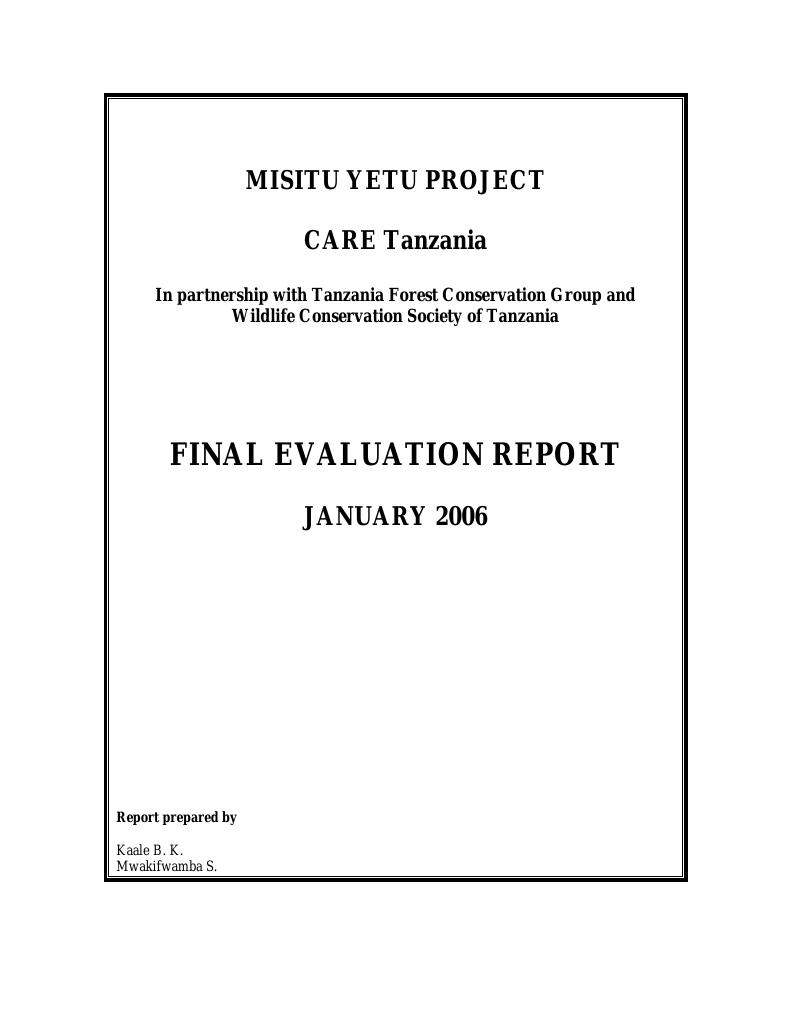Evaluering
Final Evaluation Report of Misitu Yetu Project
Background Local partners: CARE Tanzania, Tanzania Forest Conservation Group, Wildlife Conservation Society of Tanzania, the District Division of Forestry and Beekeeping, The District Division of Wildlife, the District Councils of Kisarawe and Kibaha and the Municipalities of Ilala and Kinondoni. The Misitu Yetu Project (MYP) was designed in 1999 by CARE Tanzania in collaboration with the Tanzania Forets Concervation Group (TFCG) and the Wildlife Conservation Society of Tanzania (WCST). The MYP was designed to last for five years beginning in January 2000 and ending in December 2004. The overall objective was to improve the livelihood security of forest-adjacent communities, while conserving the biodiversity of the Ruvu, Pugu and Kazimzumbi Forest Reserves in the coastal areas of the country. The sub-objectives of the project were:1. Enable participatory forest management processes, where communities in partnership with Government and NGOs are managing Coastal and Eastern Arc forests.2. Involve communities, the Government's Wildlife Department and NGOs in the conservation and sustainable utilization of resources in Pande Game reserve.3. Facilitate forest adjacent communities to manage forests.4. Engage women, men and youth in forest adjacent communities in environmentally conserving income-generating activities.5. Engage Tanzanian NGOs in influencing discussions on alternative energy uses.With a one-year extension to consolidate the project results, the project ended in December 2005. Purpose/objective The main objectives of this evaluation were to assess the extent to which the project had achieved its objectives and determine how its interventions/results could be sustained. Methodology The methodology for the final evaluation was developed through a participatory process involving MYP partners, stakeholders and the consultants. The methodology included; reviews of project document, project studies and progress reports; consultations with relevant officials and stakeholders from national to district level; field visits and discussions with village government representatives, members of village environmental committees, members of MISACA, women groups, forest product traders and primary schools; and observations of project impacts during the field visits. Key findings The main achievements of the project were:• Improved community awareness on participatory forest management and biodiversity conservation for improvements of livelihoods, taking into account gender equality and the need for women and men to cooperate in conserving natural resources.• Improved relations between villagers and the Government's Divisions of Wildlife and Forest and Beekeeping.• Enhanced understanding of the importance of clearly defined property rights in order to avoid and reduce resource use conflicts.• Intensification of tree growing and agro-forestry on farmland and in school compounds, contributing to environmental conservation and increasing the supply of wood products outside forest reserves.• Wild fires and illegal activities in Pande Game reserve have almost been stopped, leading to profuse natural regeneration of vegetation. However, the project had little impact in conserving Pugu and Kazimzumbwi Forest Reserves, as this required law enforcement and legal powers which MYP partners did not have.• The majority of saving and credit scheme members, in particular women, have increased their income levels leading to improved living standards, as they were able to cover health and education costs. However, there is a risk that microfinance, if not monitored, could exacerbate forest degradation in the process of getting initial capital and returns through sale of forest products. Additionally, the microfinance schemes have not sufficiently targeted poor people, actively involved in the destruction of the forests. The project experienced a slightly slower progress than expected due to the complex nature of the project, changes in project leadership, insufficient national policy, which did not allow for a common management of the forest resources, and an insufficient focus on the livelihood components of the project. Recommendations • In collaboration with the Wildlife Division, arrangements should be made to recruit village game scouts with the necessary skills and legal powers to conduct patrols within the reserve. MYP should also collaborate with the Wildlife Division to co-finance the preparation of management plans for the Pande Game reserve.• Poverty is the most significant underlying cause of forest destruction. The single most important factor contributing to reducing degradation of forest resources is therefore a provision of alternative ways of income for the local communities adjacent to the forest. Therefore, Local Area Conservation Network groups should receive more support in initiating Income Generating Activities and to register as CBOs where applicable and more efforts should be made in sensitizing the poor on the benefits of joining the savings and loan groups.• The issuing of licences for charcoal production should be based on proven availability of forest resources and on the principles of sustainable forest management, plus close monitoring of how the licences are utilized.• With regards to the sustainability of project interventions, the involvement of community groups, in particularly women, and their representation in all project activities should be emphasised. Comments from the organisation Evaluations are principal instruments in the follow-up of a project, and CARE Norway is devoted to continuous learning and critical assessments of our results. Lessons learned are carried forward and used to inform the design and implementation of new programmes. As this is an evaluation undertaken for CARE Norway, we urge any reader to contact us before applying this information.
